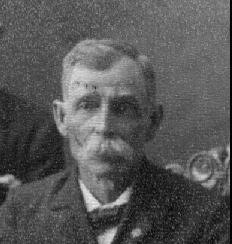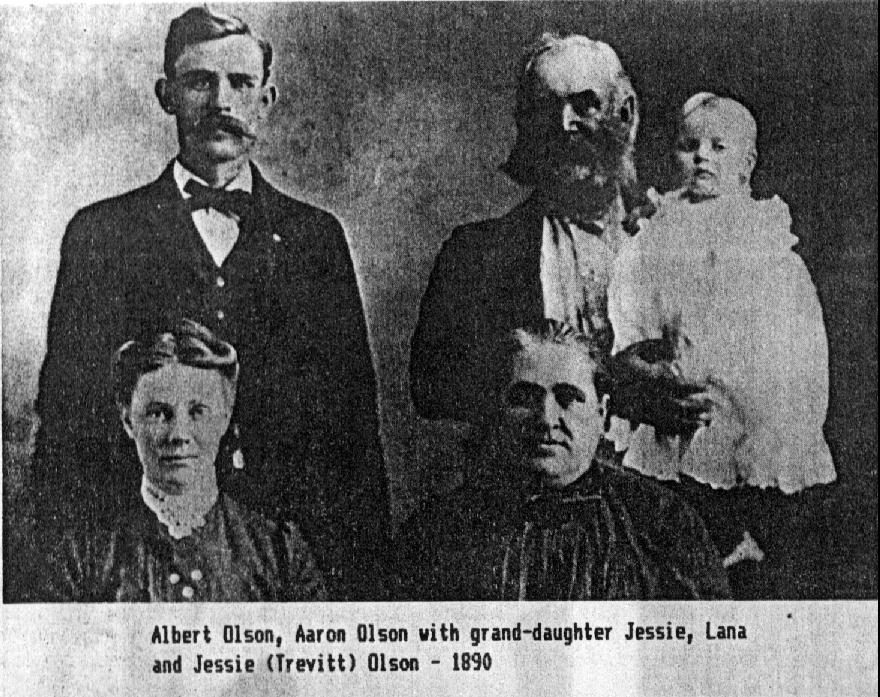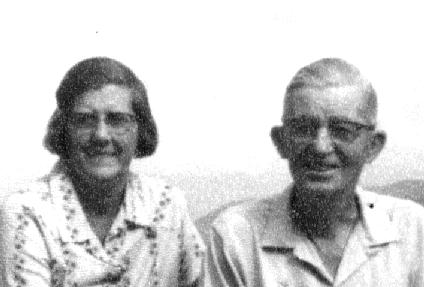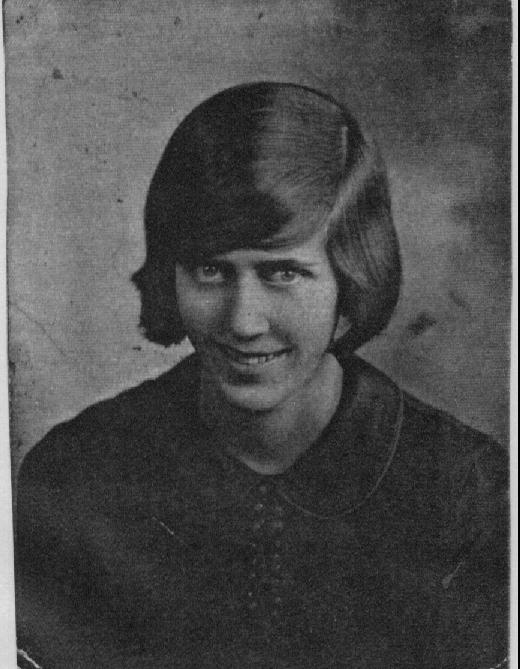ANDERSON-OLSON-TALKINGTON-TREVETT

William Anderson
We will begin this part of the family history with the story of William Anderson, Great-Grandfather of Mary Georgia Anderson. Information is scarce on him, because he never cared to talk about his past, however, a little bit of investigating has revealed that he was born in a tiny town, Columbia, Fayette County, Indiana, 2 March 1845, to Smith Anderson and ______. So far no name of his mother has been found. Smith was a peddler, and in 1850 he and his three children, William 6, Sarah 8 and John 4, lived with Smith’s father, Nicholas, and his mother, Elizabeth, in Alert Township, Decatur County, Indiana. He was evidently a widower at that time, born in 1820-21. One census shows Ohio as the birthplace and another shows Indiana. In 1860 he is still living in Alert, however, he has married a woman named Mary, and has four additional children, Nancy 8, Isaac 6, Charles 4, and David 2. Also living with them was a man, Tandy Johnson, 20 years old, probably Mary’s younger brother. In 1860 Smith is listed as a farmer. They must have married approximately 1850-51, because of the age of their first child. Further investigation will, hopefully, add information to this sketchy beginning.
William Married Mary J. Talkington, (born 22 July 1846) on 3 January 1867. They were probably married in Jackson Township, because that’s where Smith lived in 1860, however, this has not been proven. A check of the township marriage records shows marriage records as incomplete. But the microfiche of the records show that Mary was also living in Jackson Township, not far from William in 1860. Two of their children are shown on the 1870 census records, Alfred C. 2 yrs., and Noah 9 months.
When he was a young man, William moved with his family and two of his brothers (believed to be John and Isaac) to Missouri. This information came from family history and has not been proven, yet. In 1880 he was living in Nodaway County, Missouri, with Mary 32, Alfred C. 12, and George W., 7. Noah who lived one year and 10 months, is deceased, as well as Barbra, who was born in 1878 and died in 1879. There is a family dispute over the life of Barbra. Mary Hill tells that Barbra lived to be an old woman. It’s possible that Barbra Mary died as an infant and another girl was named the same name. This occurred quite often in that time period. Again, further investigation will need to be done. Also living with them is a David Anderson who is 19 years old, and the records show he is not related. It is probably William’s younger half-brother, although there is a possible one-year time difference.
Mary died 3 August 1884. It is unknown if she is buried in Nodaway County or Worth County. Many of her relatives are buried in the Sheridan, Worth County, Missouri cemetary, but we were unable to find a grave for Mary. This does not mean that she is elsewhere, it just means she could be in an unmarked grave. Mary Talkington was the daughter of Jesse Talkington, from Indiana. Also on this web page is the family story of the Talkingtons, beginning in the early 1700’s.
After Mary’s death, William remarried, as was the custom, to Sarah Adeline Rickabaugh (born 2 December 1863) and they had three additional children, Lois (Rogers), Cora (Brown) and Ethel (Toops).
William died 2 January 1907, in Sheridan, and is buried in the Sheridan cemetary. Two stones mark his grave, a military stone showing him to have been in Company C, 146th Indiana Infantry, and a small private stone showing only the dates. Sarah died 19 November 1962, at the age of 96 years.
ALFRED CARLOS ANDERSON AND ANNA MAY OLSON
Alfred Carlos was born 30 November 1868, in Decatur County, Indiana. It has heretofore been stated that Alfred was born in Anderson, Indiana. That is very unlikely; however, not far from where the family lived, is a tiny town known as Andersonville, in Decatur County, Indiana, which is much more likely to be the birthplace. While a youngster, his parents moved to Nodaway County, Missouri. Nothing is known about his early life, however, in 1891, he married Francis Cossins (1869-1901) and they had two children, Glen Orville, born 25 December 1894, and Mable Etta, born 7 April 1897. Francis was the sister of Lafayette Cossins., daughter of Samuel Nicholas Cossins and Mary Ann McCall Doonan
After Francis died, Alfred was sent to Arizona for the air to avoid catching tuberculosis. On his return home, he stopped off in Nebraska. There he met the Olsons, and on Christmas day, 1904, he and Anna May Olson were married, in Bloomington. He never went back to Missouri except to get his two children and to visit.
Anna May or Annie as she was known, (born 6 July 1885 in Bloomington, Nebraska) was the daughter of Aaron Olson and Jessie May Trevett.
Jessie Trevett (born 22 Mar 1857 in Eire County, New York) is a direct descendant of Richard Warren, signer of the Mayflower Compact. From tentative investigation, it appears she is also related to John Alden, Priscilla Mullins and Francis Cooke , all of the Mayflower. The Trevett line has, to date, been traced backwards to the year 6 AD, with further investigation going on

Aaron Olson (born 16 February 1846 in Arundel, Norway) was the son of Ole Jacobsen Olson (born 24 September 1823 in Olso, Norway) and Helga Arneson, also of Norway. Jessie and Aaron were married 31 October 1876 in Madison, Wisconsin.
Alfred C. And Anna May had six children, Hazel Barbra, Elsie Mae, Jessie Marie, who died at age six, Mary Georgia, William Aaron, and George Edward. When Glen Anderson’s first wife died two weeks after Junior was born, they also took Junior to raise.

Alfred C. Anderson with Anna May Olson

Donald Hill with Kathleen Renee Crawford
Alfred farmed all his life. He was a tall, handsome man with a mustache. When younger, his hair was dark, but became gray as he got older. A picture of him taken on his wedding day shows that genes are strong and pass down through the generations. Don Hill, son of Howard (grandson of Alfred) and Bonnie is almost a clone of Alfred. The similarity between the two is startling. (see inset above) I’ve said that as long as Don is alive, Alfred won’t be dead. Alfred served on the Bloomington, Nebraska school board and was interested in his children getting a good education. He liked to listen to baseball games on the radio and kept his own box scores. He loved his garden and raised watermelons by the wagonload. Mary remembers him playing "Pop Goes the Weasel" and other songs on a jews harp.
In 1950, Ted Hill and Mary bought the Anderson family farm from Alfred. For a while Alfred lived with them but eventually they were forced to place him in a nursing home. He died of a cerebral hemorrhage and cerebral arteriosclerosis on 10 June 1952..
Anna May was a small, petite woman, who didn’t weigh much more than 100 pounds when they were married. She became stouter as she got older. She was a good wife and mother. Grandchildren remember spending the night at Grandma’s house., tying to milk the cows, helping to use and wash the milk separator, making butter, gathering eggs, eating fresh fried chicken and watermelons chilled in the well, roaming the creeks and pasture. Grandmas was always patient and kind. She developed cancer of the pancreas and that was the eventual diagnosis of death. Mary said she suffered a long time and weighed only 96 pounds when she died, 1 October 1946.
Howard remembers going to Grandma and Grandpa’s house for a big "get together" on Sundays, having dinner, swimming in the creek, and picking fruit.
TED "S." HILL AND MARY GEORGIA ANDERSON

Ted and Mary - 1960
Ted S. Hill was originally named Todd Lincoln Hill, after the son of Abraham Lincoln, and disliked his name so much he changed it to Ted, with the "S" supposedly taken from Dr. Sumner, the doctor who birthed him. He was always a farmer until later in his life when his health and the health of his son forced them to sell the farm and move to Arizona. Fenton Hill, Ted’s father was also a farmer, however at one time he helped on building the Salt Lake City Mormon Temple and also owned and ran a livery stable north of the fire station in Bloomington. Ted was born 3 May, 1901, in Bloomington, Nebraska.
Ted and Mary grew up in the same area and Ted always said he waited for Mary to grow up so they could get married.
Mary was also born in Bloomington, 31 July 1912. She was a little over 11 years younger than Ted. Mary said her mother always told her she was named after her two grandmothers, Mary Talkington and another, however no Georgia has yet been found. She said she would much rather work in the fields with her dad than do housework. She tells of helping him load hay and drive the horses. She graduated from Bloomington High School in 1930. A little over a year later (16 October, 1931), she and Ted ran away to Smith Center, Kansas and were married. When they got back, Ted drove the car up and into the big barn. Ted and Mary walked down the road and heard the folks from town coming to shivaree them. They ducked under the Lost Creek bridge and Fenton told the visitors they weren’t there so everyone took off. When they were gone, Ted and Mary came out from under the bridge and walked back to the house. Later a shower was given for the couple. Mary still has a list of the gifts they received, including a jar of peanut butter. The license for them to get married cost $10.00 and Ted only had $12.50, so they only had $2.50 afterwards. They stopped and got beefsteaks for the 3 of them.
To their union, five children were born, Geraldine Mary (24 August 1932), Dorothy Lee, (18 September 1933). Howard Ted (20 November 1934,) Barbra Ann (Stillborn 18 March 1936) and Kenneth Jerome (8 October 1938).
In 1955 Ted and Mary sold the farm and moved to Arizona. Ted was having breathing problems, and also suffered from excessive coughing. The dust created by plowing and farming probably exacerbated the problems. Kenneth also had a heart murmur and it was thought that the desert would help him. There seemed to be no improvements in either one, and a doctor told them to move Kenneth to Idaho to the high mountain air. So in 1956 they moved to Emmett, Idaho.
Ted got a job as a bailiff at the County Jail and served in that capacity for several years. Then he began testing milk for dairymen and had that job until he got sick and had to quit. He died of bronchial obstruction, pulmonary inflammation, and bronchogenic carcinoma, 10 February 1965. He is buried in the Maple Grove Cemetary in Bloomington, Nebraska. He is on one end of the plot, and David Anthony, son of Howard and Bonnie is on the other end.
For several years Mary maintained the 4 apartments they had owned at the time of Ted’s death. She rented them out and also worked as a cook at a nursing home for several years. When she could no longer keep up the apartments, she sold them and moved into Senior Citizen housing in Emmett.
Geraldine and Dorothy married brothers, Bill E. and Jack M. Dodson, from Nebraska. Bill and Gerry lived and worked on a few farms in the area before Bill finally developed his own land leveling business. They eventually settled in Loomis, Nebraska and had six children.
Dorothy and her husband followed Ted and Mary to Idaho in early 1959. They also had six children. Jack went to work in the maintenance department for the City of Emmett, and eventually became the supervisor. Jack and Dorothy were divorced in 1987.
Kenneth joined the army in 1958. While in the East, he met and married Margaret Thompson in Williamsburg, Virginia. They built a home there, on a piece of her family property, and had four children, Mary Theresa, Teddie Lynn, Glen and Michael. Kenneth, for many years worked in Newport News, Virginia as a civilian electrician for the U.S. Navy. After retirement he worked at various other projects, including operating a draw bridge.

Mary Georgia Anderson - 1930
Some time ago Mary wrote a short synopsis about her memories of life. Following is that summary.
"Mom taught me to cook. In January when I was 16 and it was very cold, she was sick. Bill had to walk to town and get medicine from Dr. Sparks. While he was gone she told me to boil some watermelon seeds and make her some tea as her kidneys wouldn’t work and by the time Bill got home, frozen, she was much better and they were working but she took the medicine. That’s when I learned how to bake bread. It turned out pretty good. We had lots of rhubarb and always made pies. When I was in the 8th grade at graduation time, dad told me if I fixed and sold the rhubarb in the stores I could have the money for my dress and shoes. I sold more than enough. Dad, when he lived in Mo., helped train or cared for a race horse and I think it was Man Of War.
"One day Bill and I didn’t want to help Mother wash as we had to run the washer by hand and we’d get tired so we decided we’d go get the mail. When we got back we didn’t go back to the house. Soon a big plane went over and we went to the house to watch with the rest and along about that time here came dad with the razor strap and we got it. But that was the only one we ever got and we deserved it.
"I liked to help Dad in the field. I’d ride the horse and drive her in the garden. Once, when we were cultivating corn up at the north side of the place, he put me on old Bill and I was fine till he started down a hill. Then I couldn’t stay on.
"When we lived south of Franklin, Elbert Berry lived in back of the house on the creek and he helped us a lot. He’d walk over to Reams’ and call the Doctor when we needed one. Ted helped Jansen’s bale straw and it was in the dust bowl and he came home with dust pneumonia and the doctor came out. And he went after Dr. Bratt again when I lost our baby. He lived in a sheepherder’s wagon.
"Ted cut cottonwood trees to sell to Goldsburg bakery. They paid him $20 for a big wagon load, which he hauled in to them. Cottonwood would keep an even fire for baking.
"The Copleys were wonderful people. They had a lot of cattle but no water and we had plenty of water so they’d drive them over every day to drink. When they butchered we always got a half beef. She kept the kids the day we went to Holdrege when Kenny was born. Nobody had much to eat so we all helped each other. They never forgot that. We asked Chris to be a pall bearer at Dad’s funeral and he said he was honored. They are all gone now but Elton and Stanley.
"I had Dot at home on Austin Carroll’s place north of Bloomington and we had a nurse, Dorothy Thompson. After Dot was born her kidneys wouldn’t work so she called her mother and she said to boil watermelon seeds and give that to her and she did and it worked.
"When we moved to Grandpa’s farm, I took a load and went on ahead and Ted brought the horses. They went fine ‘til they came to a bridge and old Funny wouldn’t cross. I don’t remember how he got them across. May have covered his eyes, but he hurt his knee and when he got home he could hardly walk. Howard helped drive the cattle down.
"Dad (A.C. Anderson) had a little team of mules that they’d drive to town and one day crossing Little Cottonwood where Ted and his folks lived, they got scared and ran off and upset the buggy or wagon. Ted’s folks came down and picked us all up and put the buggy upright (I think it was a spring wagon) and caught the mules, and we all went on to town. They were always running off. He’d start to shuck corn and away they’d go, so he made them run ‘til they stopped, then he went back and picked corn.
"I wasn’t quite 3 when Jessie died. I can remember her being sick and going to her funeral in a wagon. I asked Mom where Jessie was and she told me "to heaven".
"Dad and Mother came up next day after Dot was born and Dad took one look at her and said, "That’s little Dot." And it stuck. Kids liked to stay with the grandparents.
"When I was 8 or 9, Grandma and Aunt Nellie (Olson) drove their horse and buggy down and we picked strawberries for them. We had a big patch that dad watered from the pond. We’d pick them by the wash tub. They took home plenty. Grandma didn’t last long after that. Grandma had one of those stereopticons you look through and we kids would head for the old house and sit and look at those pictures.
"When Uncle Charlie Johnson died, Bill and I got a chair and put it beside the casket. We tried to get him to open his eyes. We didn’t get caught at it.
"Mom always called Dad "Papa".
"Hazel worked out when a girl. She worked for Rose Gardner, Swede’s Mother, and for Charlie Howell. Elsie went to school.
"When the gas company put in the gas line through Dad’s place, Bill worked on it and got overheated and was really sick.
"When we lived on Joyce’s farm, Ted and Gerry went to Franklin one day and saw a little calf in the road. No cows were around it so they loaded it into the car and brought it home. The kids also had pet pigs, lambs, horses, calves and cows.
"When Ted and I went to Hastings before we were married to get my ring, Dad gave us $100 to buy what we needed. We bought a set of dishes, a dresser, and don’t remember what else, but Ted got my ring. On the way up there we stopped in Blue Hill and they had grapes so Ted bought a basket. Then he bought some sure-jel so Mom could make us jelly. When we bought the sure-jel, they gave us a pink dish with a handle on it, and I still have it. We got a blue carnival glass plate for a wedding present from Ralph and Pauline Douglas.
"We had 7 1/2 inches of rain on Ike’s place so everything flooded but the house. We lost little lambs, little pigs and all the canned goods in the cellar.
"Lawrence Gosnell had a little white pony he let the kids ride as long as we lived there. All four kids could ride her.
"When we lived on Joyce’s, we didn’t raise much. Henry Story had a big crop of corn so he hired Ted to shuck it. I helped after getting the kids off to school and we’d pick 3 loads in a day. Around 50 bushels a load.
Ted traded work with Philip so we all had help. He traded work with Swede Gardner, too.
"I helped Dad put up hay when I was about 14. From then on I did about everything but mow. Dad wouldn’t let me do that. But I raked it, bunched it and used the buck to buck it up on the stack. I cultivated the corn and helped shuck it. Dad sent Bill and I after the cows and he took the load of corn to the house. We had to crawl through the barb wire fence and I put my hand down on the ground and got a mitten full of sand burrs. I’d watched Dad pick them out with his teeth and blow them out. Well I picked one out and instead of blowing it out, I took a deep breath and sucked it back into my throat. Dr. Sparks took Mom and I to Hastings to the Hospital. Dr. Foote finally got it out. I had coughed so much it was embedded in my vocal cords. Dad wouldn’t let me shuck corn after that. But I did plenty after we were married.
"When the bank in Bloomington failed in 1929 or 30 (must have been 30 because we were married), Kenneth Douglas worked in the bank. He and Ted were good friends so he told Ted to tell Dad to be ready and he’d see that he got some money out of his bank account. Can’t remember how much he got, but he gave Ted some of it."
Home || My Story || Benjamin Williams Story || Name Search || Links ||
Talkington Story || Weber Family Story
|| Marvin Hill Story || Pedigree Charts
|| Jessie Trevett Story ||Owen Beginnings||Wills || Anderson/Olson Story || Christopher Kirby Family || My Memory ||
